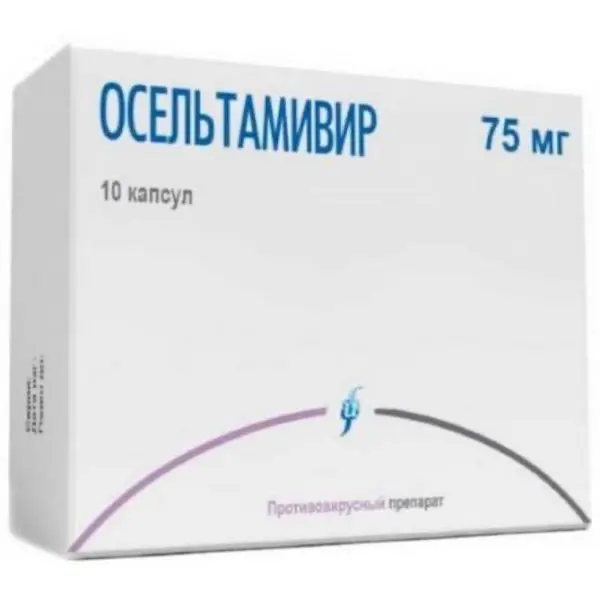Description
Oseltamivir Pharmacodynamics
Antiviral drug, oseltamivir phosphate is a prodrug, its active metabolite (oseltamivir carboxylate, OC) is an effective and selective inhibitor of influenza virus neuraminidase type A and B – the enzyme that catalyzes the release of newly formed viral particles from infected cells, their penetration into uninfected cells of the respiratory epithelium and further spread of the virus in the body. Inhibits influenza virus growth in vitro and suppresses virus replication and pathogenicity in vivo, reduces the release of influenza A and B viruses from the body. Studies of clinical influenza virus isolates have shown that the concentration of OC needed to inhibit neuraminidase by 50% (IC50) is 0.1-1.3 nM for influenza A virus and 2.6 nM for influenza B virus. According to published studies, the median IC50 value for influenza B is slightly higher at 8.5 nM.
Indications
Flu treatment for adults and children over one year of age.
Influenza prophylaxis in adults and children over 12 years of age in groups at high risk of contracting the virus (in military units and large communities, in debilitated patients).
Flu prophylaxis in children over 1 year of age.
Contraindications
Hypersensitivity to oseltamivir phosphate or any drug component, terminal renal failure (creatinine clearance ?10 ml/min), severe hepatic insufficiency, children under 1 year of age.
Precautions
Caution
Pregnancy, breast-feeding.
Administration during pregnancy and lactation
Controlled studies in pregnant women have not been conducted. However, the results of post-marketing and observational studies have demonstrated the benefit of the proposed standard dosing regimen for this patient population. Results of the pharmacokinetic analysis showed lower exposure of the active metabolite (approximately 30% across all trimesters of pregnancy) in pregnant women compared to non-pregnant women. Nevertheless, the estimated exposure value remains above inhibitory concentrations (IC95 value) and therapeutic values for many strains of influenza virus. Changing the dosing regimen in pregnant women during therapy or prophylaxis is not recommended. No direct or indirect adverse effects of the drug on pregnancy, embryo-fetal or postnatal development have been found (see “Preclinical data”). When prescribing oseltamivir to pregnant women, both safety and pregnancy data and the pathogenicity of the circulating strain of influenza virus should be considered.
Dosage and administration
- Orally, with or without meals. Tolerability may be improved if the drug is taken with meals.
- If adults, adolescents and children have problems swallowing the capsules or if there are signs of “aging” of the capsules (for example, increased fragility or other physiological disorders), you should open the capsule and pour its contents into a small amount (maximum 1 teaspoon) of a suitable sweetened food (chocolate syrup with normal or no sugar content, honey, light brown sugar or table sugar dissolved in water, sweet dessert, condensed milk with sugar, The mixture should be thoroughly mixed and given to the patient whole. The mixture should be swallowed immediately after preparation.
- Standard dosing regimen
Treatment
The drug should be started no later than 2 days from the development of symptoms of the disease. - Adults and adolescents aged? 12 years
The recommended daily dose is 150 mg. The drug is prescribed in a dose of 75 mg (one capsule 75 mg or one capsule 30 mg + one capsule 45 mg) 2 times a day orally for 5 days. - Children who weigh more than 40 kg or who are 8 to 12 years of age
- Children who are able to swallow capsules may also be treated by taking 75 mg (one 75 mg capsule or one 30 mg capsule + one 45 mg capsule) 2 times daily for 5 days.
- Children 1 to 8 years of age
Recommended dosing regimen for oseltamivir 30 and 45 mg capsules or extemporaneously prepared suspension - Body weight Recommended dosage for 5 days
?15 kg 30 mg twice daily
>15-23 kg 45 mg twice daily
>23-40 kg
> 40 kg
60 mg twice a day
75 mg twice a day - Prophylaxis .
The drug should be started no later than 2 days after exposure. - Adults and adolescents aged ?12 years
Take 75 mg (one capsule of 75 mg or one capsule of 30 mg + one capsule of 45 mg) once daily orally for at least 10 days after exposure. During a seasonal influenza epidemic – 75 mg (one capsule 75 mg or one capsule 30 mg + one capsule 45 mg) once a day for 6 weeks. The prophylactic effect lasts as long as the drug intake lasts. - Children who weigh more than 40 kg or are 8 to 12 years of age
Children who can swallow capsules may also receive prophylactic therapy by taking 75 mg (one 75 mg capsule or one 30 mg capsule + one 45 mg capsule) once daily for 10 days. - Children between 1 and 8 years of age
Recommended dosing regimen of oseltamivir 30 and 45 mg capsules or extemporally prepared suspension: - Body weight Recommended dose for 10 days
?15 kg 30 mg once daily
>15-23 kg 45 mg once daily
>23-40 kg
>40 kg 60 mg once daily
75 mg 1 time per day - Dosage in special cases
- Patients with impaired renal function
- Treatment
Dosage adjustment is not required in patients with a creatinine clearance of more than 60 ml/min. In patients with creatinine clearance from 30 to 60 ml/min the dose of oseltamivir should be reduced to 30 mg twice daily during 5 days.
In patients with creatinine clearance from 10 to 30 ml/min, the dose of oseltamivir should be reduced to 30 mg once daily for 5 days. In patients on permanent hemodialysis, oseltamivir at the initial dose of 30 mg can be taken before dialysis if influenza symptoms appear within 48 h between dialysis sessions. To maintain plasma concentrations at therapeutic levels, oseltamivir should be taken 30 mg after each dialysis session. In patients on peritoneal dialysis, oseltamivir should be taken at an initial dose of 30 mg before dialysis, then 30 mg every 5 days.
Pharmacokinetics of oseltamivir in patients with end-stage chronic renal failure (with creatinine clearance ?10 ml/min) who are not on dialysis have not been studied. In this regard, there are no dosing recommendations for this group of patients. - Prevention
Dosage adjustment is not required in patients with creatinine clearance greater than 60 ml/min. In patients with creatinine clearance from 30 to 60 ml/min the dose of oseltamivir should be reduced up to 30 mg once per day. In patients with a creatinine clearance of 10 to 30 ml/min, it is recommended to reduce the dose of oseltamivir to 30 mg once daily. In patients on permanent hemodialysis, oseltamivir at an initial dose of 30 mg can be taken before dialysis. To maintain plasma concentrations at therapeutic levels, oseltamivir should be taken 30 mg after each subsequent odd-numbered dialysis session. In patients on peritoneal dialysis, oseltamivir should be taken at an initial dose of 30 mg before dialysis, then 30 mg every 7 days.





